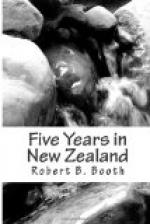Mr. Lee’s run comprised about 30,000 acres, principally hills, with occasional stretches of flat land upon which the cattle and horses grazed, while the sheep fed on the mountain sides.
We speedily fell into the life, and found it exhilarating. Mr. Lee was a fine specimen of the English country squire, a good horseman and sportsman, and he could put his hand to any kind of work. He had a large store and workshop near the yards, where every conceivable thing needed for use on a station so far from supplies was kept, and he was an excellent carpenter and smith. Indeed, a great portion of the rather extensive buildings and yards he had erected himself, with such assistance as he could derive from raw station hands, while only such articles as doors and windows, furniture, and suchlike were brought from Christchurch. The house walls, roofs, and floors were all of green timber cut in the neighbouring pine forest. The walls of the living houses were composed of a framing of round pine averaging 4 or 5 inches thick, covered on the outside with weather boarding, and on the inside with laths, the space between of four inches being filled with clay and chopped grass, and the whole surface afterwards plastered with clay and mud-washed. The roofs were made of pine framing covered with boards and pine shingles. The outbuildings were usually built with roughly squared framing to which heavy split slabs would be vertically fastened, the inside being left rough or plastered with mud as desired; and the roofs were of round pine framing covered with rickers (young pine plants) and thatched with snow grass. Squatters soon learnt to be their own architects, and very good ones many of them turned out.
The country immediately surrounding the station was almost treeless, and Mr. Lee was doing a good deal of planting, and had a very fine garden under formation. Some two miles to the rear of the station, in a deep cleft of the hills, lay a considerable black and white pine forest. It is a peculiarity of New Zealand that the pine forests indigenous to that country (and which bear no similarity to European pines) are invariably found in more or less accurately defined patches, growing thickly and never scattered to any appreciable extent. One may ride twenty miles through spurs and hills with no vegetation on them, and then suddenly stumble on a densely wooded ravine or mountain side so accurately contained within itself as to lead one to imagine it had been originally planted.




